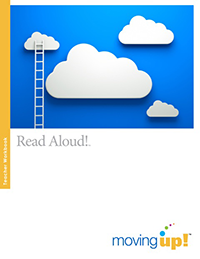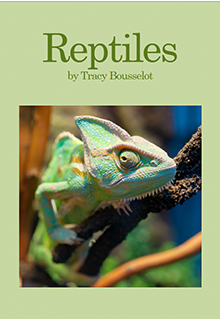Read Aloud!

Read Aloud! consists of two Moving Up! Literacy programs designed to promote vocabulary and comprehension in K – 2.
- Read Aloud! – Whole Group is a Tier 1 program designed for whole class instruction.
- Read Aloud! – Small Group is a Tier 2 program that reinforces the content learned from the information texts in the Whole Group program.
- K
- - 2
- Curriculum
Delivery Information: PDFs are delivered within 2 business days and the printed books within approximately 6-7 weeks.
Teachers in the early grades read aloud to their students to model fluent reading and help their students develop an appreciation of literature. The Read Aloud! – Whole Group and Read Aloud! - Small Group programs take read aloud to the next level by integrating vocabulary and comprehension instruction without losing the feel of traditional read aloud time.
The Read Aloud! – Whole Group and Read Aloud! – Small Group programs complement each other. Both programs:
- include a pre-unit used to introduce strategies utilized throughout the program.
- include nine instructional units organized around themes:
- Mammals (units 1-3),
- Reptiles (units 4-6), and
- Insects (units 7-9).
- are intended for use in grades K-2 within a Response to Intervention approach.
- include detailed instructions in the Lesson Guide to differentiate instruction for students who are at risk for academic difficulty, deaf or hard of hearing, learning English or have learning disabilities.
- feature text-based conversations before, during, and after read alouds.
- strategically reinforce vocabulary by including some of the same target vocabulary words in both programs.
- are aligned with Common Core State Standards. Student goals include:
- identifying the purpose for reading,
- summarizing text by retelling,
- noting key ideas and specific details,
- using monitoring strategies during reading,
- using target vocabulary in discussions,
- increasing discussion about specific texts in groups and with partners, and
- making text-to-self, text-to-text, and text-to-world connections.
Both Read Aloud! programs were developed and implemented in large scale efficacy research sponsored by the U.S. Department of Education, Institute of Education Sciences with support for implementation from the Pacific Institutes for Research and the University of Oregon. The Read Aloud! programs align with the Common Core State Standards, Next Generation Science Standards, and National Science Education Standards.
Differences between the Read Aloud! – Whole Group and Read Aloud! – Small Group Programs
| Characteristic | Read Aloud! – Whole Group | Read Aloud! – Small Group |
|---|---|---|
| Books used during read aloud instruction | One thematically paired information and storybook, commercially published, for each instructional unit* | Information books, written specifically for Read Aloud! – Small Group, provide continuity throughout the program |
| Number of lessons per unit | 6 to 7 (3 with each information book and 3 to 4 with each storybook) | 4 |
| Length of lessons | 30 minutes | 20 minutes |
| Size of instructional groups | Whole class | Small groups (2 – 5 students) |
| Target students | All students | Students struggling with vocabulary and comprehension strategies |
| Response to Intervention tier | Tier 1 | Tier 2 |
| Compatibility with other programs | May be used with or without the Read Aloud! – Small Group program; can supplement any core reading program or science program on the study of living things | Reinforces Read Aloud! – Whole Group; can be used alone or as a supplement to any science program on the study of living things |
| Activities | Student retelling and structured partner discussions | Question asking and answering, key ideas and details, animal classification, vocabulary knowledge and use |
* Published trade books are required and may be purchased from book retailers.
Materials are available in two different formats:
- Convenient, downloadable PDF format. Once the PDFs are purchased, copies may be made according to the Distribution License Agreement.
- Pre-printed by the University of Oregon Printing Services Department.
Sample Lessons
The Read Aloud!: Developing Narrative and Scientific Literacy – Whole Group kit includes:
- a comprehensive Lesson Guide.
- a complete set of Lessons with Detailed Lesson Plans, and abbreviated Lesson Cards.
- a K-W-L Chart for classroom display when using information text.
- Information Retell Sheets and Story Retell Sheets for classroom display and student use to help organize content for retell practice.
- Vocabulary Cards for displaying words taught in the curriculum.
- a list of commercially available trade books required for program implementation (Published trade books are required and may be purchased from book retailers.)
The Read Aloud!: Developing Scientific Literacy – Small Group kit includes:
- a comprehensive Lesson Guide.
- a complete set of Lessons.
- fun Vocabulary Games, with Word Cards, Definition Cards, Picture Cards, and Examples and Non-examples Cards.
- Animal Cards, with photographs and illustrations for use during text-based conversations and lesson activities.
- Reading Detective Activities with Reading Detective Questions, Clue Cards, and Clue Sheets.
- an Animal Classification Set for use in comprehension strategy instruction.
- a Game Package including Review the Clues!, Question This!, and Word Wise Bingo.
- Reading Detective Rules Poster to convey group and partner rules.
- nine illustrated Big Books (8.5” x 14”) containing informational text. (May also be ordered separately.)


CTL is aware of the following providers of the full set of trade books used in the Read Aloud! Whole Group curriculum:
1) Classroom Library Company
3901 Union Blvd., Suite 155
St. Louis, MO 63115
PH: 888-318-2665
Email: sales@classroomlibrarycompany.com
Quote Name: CTL RA 032415CT
The University of Oregon (UO) Center on Teaching and Learning (CTL) does not endorse or have a relationship with The Classroom Library Company, nor does it require customers to purchase books from any particular vendor. Other vendors may contact ctl@uoregon.edu to have a link or ordering information regarding the set of trade books associated with the Read Aloud! - Whole Group program added here.
Our Research to Your Classroom
CTL has conducted rigorous research on the use of both Read Aloud! – Whole Group and Read Aloud! – Small Group for increasing the vocabulary and comprehension skills of at-risk first-grade students. These programs were developed and evaluated with funding from the U.S. Department of Education’s Institute of Education Sciences (IES).
Read Aloud! – Whole Group was evaluated in 12 first-grade classrooms with 225 students. The 19-week study involved intervention teachers implementing the Read Aloud! – Whole Group curriculum, while teachers in the comparison condition implemented the same amount of read aloud instruction, focusing on vocabulary and comprehension strategies they believed would help their students. Using a main-effect model, Read Aloud! – Whole Group had significant effects on students’ expressive narrative comprehension and vocabulary outcomes, with effect sizes of .42 and 1.02 respectively. An effect size indicates the difference in number of standard deviation units between the intervention and comparison groups. These effect sizes represent substantively important differences. Results from the study also revealed that a range of students (e.g., low-risk, language-risk, literacy-risk, combined risk) benefited from the whole group read aloud instruction.
Baker, S. K., Santoro, L. E., Chard, D. J., Fien, H., Park, Y., & Otterstedt, J. (2013). An evaluation of an explicit read aloud intervention taught in whole-classroom formats in first grade. Elementary School Journal, 113(3), 331-358. doi: 10.1086/668503
Santoro, L. E., Chard, D. C., Howard, L., & Baker, S. K. (2008). Making the VERY most of read alouds to promote comprehension and vocabulary. Reading Teacher, 61 (5), 396-408. doi: 10.1598/RT.61.5.4
Read Aloud! – Small Group was evaluated in 18 first-grade classrooms, including 102 students who scored below the 50th percentile on the Relational Vocabulary subtest of the Test of Oral Language Development-Primary (TOLD-P:3). Within classrooms, students were paired and randomly assigned to either the intervention or comparison condition. Students in both conditions participated in the Read Aloud! – Whole Group curriculum. Students in the intervention condition also participated in two 20-minute Read Aloud! – Small Group lessons per week for eight weeks. Students in the comparison condition did not receive additional instruction. Using a three-level hierarchical linear model analysis, results showed that students in the intervention group outperformed control students on vocabulary knowledge (g010 5.98, t = 3.44, p < .01) and expository retells (g010 0.89, t = 2.87, p < .01) with effect sizes of .67 and .57 respectively. These effect sizes represent substantively important differences.
Research on the Read Aloud! – Small Group program was reviewed by the National Center on Intensive Intervention (NCII). NCII rated the study as having “convincing evidence” in all five areas reviewed: research design, participants, fidelity of implementation, targeted measures, and broad outcome measures.
Fien, H., Santoro, L. E., Baker, S., Park, Y., Chard, D., Williams, S, & Haria, P. (2011). Enhancing Teacher Read Alouds With Small-Group Vocabulary Instruction for Students With Low Vocabulary in First-Grade Classrooms. School Psychology Review, 40 (2), 307-318.
This list does not constitute an endorsement of any of the trainers nor are CTL Marketplace licensees required to work with anyone on the list. CTL Marketplace licensees may work with any trainer of their choice. Our list is made available solely as a convenience and service to the public. Individuals with professional credentials who would like to be listed as trainers can contact us at ctl@uoregon.edu. Trainers listed below provided their own biographies and contact information.